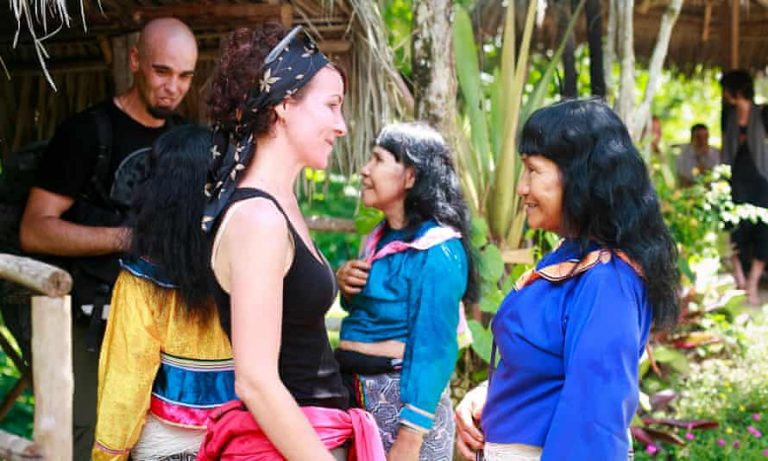Contents
The new tourism boom from the westerners seeking spiritual experience from the Holy Medicine of the Holy and Divine Mother Ayahuasca has brought new attention, new money and new problems to traditional shamans and communities in the Amazons, resulting in misrepresentation of traditional practices as well as exploitation of innocent tourists.
The native shamans are eager to offer tourists their wisdom, and the tourists get a chance to attain spiritual experiences and receive Secrets from the Rainforest.
Typical promotional of the Holy Medicine and Sacred Ceremonies would include offerings such as the following
- Personal cleansing and transformation
- Deep connection to nature
- Opportunity for release on inner levels we may not have touched into before
- A safe place where people can come for ceremony and healing
- Deep healing
- Shamanism
- Mysticism
- Spiritual transformation through personal experience
- Transformation and personal growth
- Mystery and transformational power of sacred traditional rituals
The typical tourists
The tourists are typically white, urban, relatively wealthy, well educated, and spiritually eclectic outsiders. Almost always, the goal they are seeking to achieve is not intellectual or scholarly understanding of the indigenous culture but rather personal, spiritual growth, healing, and transformative experiences – like spiritual relations, personal spiritual development, personal self-awareness, emotional healing, and access to deeper levels of the self.
Why tourists do not get authentic traditional Sacred Ceremonies
As tourists are visiting for personal transformation and healing, they are not bothered to know or are looking for traditional approaches to shamanism, and therefore, to cater to their ‘expectations’ they are being offered hybrid and customised Sacred Ceremonies, incorporating various new-age themes and concepts, which are not a part of the traditional Sacred Ceremonies in Amazons.
Exploitation of the western tourist by fake or tourist-based shamans
Due to the huge demand of shamans and spiritual experiences from the tourists, many tour guides have become overnight shamans and traditional healers by learning to prepare the Holy Medicine, and has memorised many Holy Icaros to be able to ‘get through’ their organised Sacred Ceremony, who fight among themselves and also make a lot of money. As performance artists Guillermo Gomen-Pena refers to them as “a hyper-exoticized curio shop shaman for spiritual tourists”.
Neo-shamans
On another hand, to serve western tourists, anthropologist Luis Eduardo Luna, an early investigator of mestizo shamanism, has formed the Wasiwaska Research Centre for Study of Psychointegrator Plants, Visionary Art, and Consciousness in southern Brazil, where he himself has become the healer, providing a “secure, supportive environment for intense internal exploration. He has included holotropic breathwork, artistic expression, workshops, lectures, and Rainforest excursions.
Dilemma of traditional shamans in modern times
It can be seen how different groups have sprung up to serve the tourists, although they are not promoting traditional Sacred Ceremonies as they are not shamans who go through studies for years. Nowadays, traditional shamans have to compete with these tourist catering tour guide shamans.
The dilemma for traditional shamans are profound – with tourists dollars being able to support them while they continue to treat their local community for low cost. Or for some it could even be a choice of leaving their communities behind – for a more affluent life in tourist towns or lodges. While a shaman can earn hundreds of dollars per month serving tourists and students, others in the area sell handicrafts and do similar jobs for pennies.
How local shamans are innovating and adapting with changed times
Shamans have been learning to adapt, with few like Calderon, who serves local Peruvian clients in one setting and context, and has a separate way of serving spiritual tourists, mediating between traditions and expectations and understanding of outsiders, adapting with new socio-cultural circumstances.
When accused of selling out, a shaman said “I am an innovator, adding to my ancestral knowledge. We can’t just stay the same so that tourists can stare at naked Indians in feathers, and the anthropologists can treat us like a living museum. The Shipibo people need to grow and change”.
One solution to the problem
One good example of an organisation which has found a way to solve the problem of maintaining the tradition and not change the successful ways of Sacred Ceremonies in the Amazons by giving into tourists’ expectations is “Howard Lawler’s El Tigre Journeys”. It provides extra income to traditional mestizo shamans for performing Sacred Ceremonies for foreign tourists in an authentic way, following traditional dietary restrictions. The shamans continue to work with their communities and work with the organisation on part-time basis. The participants are able to join in groups limited to 12 participants in each group, who are also given trips to ethnobotanical resources like the Alpahuayo-Mishana Rainforest. The local people are provided Sacred Ceremonies free of charge to receive ‘Healing’ from the Holy and Divine Mother Ayahuasca. The tourists’ dollars are utilised to sponsor community development projects for nearby Bora, Yagua, and Huitoto villages – a building for a community medical clinic, a twelve-meter wooden-hulled boat and motor, a facility for a village-owned cooperative general store, and a community chicken farming.
Conclusion
Such initiative as the “Howard Lawler’s El Tigre Journeys” provide the solution of integrating the growing demand from spiritual tourists with traditional Sacred Ceremonies.
Reference
- Beyer S. V., 2009, Singing to the Plants: A Guide to Mestizo Shamanism in the Upper Amazon, University of New Mexico Press, USA.


